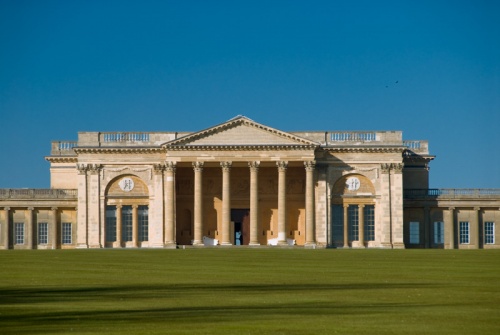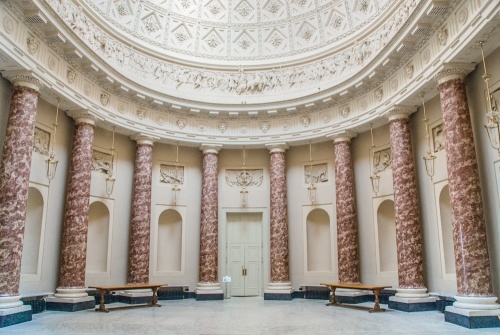
The house at Stowe tends to be overshadowed by the landscape gardens in which it is set, which is understandable given the influence that Stowe Landscape Garden has had on the history of gardening. The house, however, is well worth a visit in its own right, so if you can combine a visit to the house with time spent exploring the gardens, you will find you have spent an afternoon - or a whole day - very well.
The history of Stowe House makes fascinating reading. The house was established, not by a member of the nobility, as you might expect, but by a prosperous sheep farmer named Peter Temple, a native of Witney in Oxfordshire. Temple saw the land at Stowe while taking his sheep to market at nearby Buckingham.
Despite their yeoman status, the Temples claimed as ancestors Leofric, Earl of Mercia, and his famous if scantily clad spouse, Lady Godiva. While this association may or may not have been wishful thinking, it did indicate the Temple's desire for social status, something that members of the family were to exhibit in abundance over the coming centuries.
In 1571 Peter Temple leased the land at Stowe. At that time there was an existing medieval house on the site, but that would some become inadequate, for the Temples were inspired to social success. John Temple, Peter's son, purchased the land outright in 1589. John's son, Thomas really began the long climb up the social ladder by purchasing a baronetcy from King James I in 1611, but it was left to Sir Thomas's grandson, Richard Temple to begin the building of what would become Stowe House in 1680.

most striking rooms in England
Richard Temple was succeeded by his son, also named Richard (later Viscount Cobham), and it was he who began the design of the landscape gardens for which Stowe is famous (see our article on Stowe Landscape Gardens.
Though much of Viscount Cobham's attention was focused on the development of the gardens at Stowe, he did not neglect the house. Indeed, the extravagance with which the Temple-Grenvilles lavished money upon Stowe House is reflected in the fact the house became known as 'Stowe Palace'.
Viscount Cobham's nephew was Richard Temple-Grenville, later named Earl Temple, and he inherited the estate in 1749. It was Earl Temple who is responsible for much of the splendid work on Stowe House that we can admire today.
Temple added the colonnade on the north front. He initially called in Robert Adam to design the South Front, but he was unsatisfied with the result of Adam's design and turned to his cousin, Thomas Pitt, to finish it in a manner more to his taste. The result is perhaps the best example of neo-classical style still in existence in Britain.
The beautiful neo-classical interiors were designed over a period of decades by a number of architects employed by Temple and his nephew, the Marquess of Buckingham, among them Blondel, Valdre, and Borra. All three of the above worked on the Marble Saloon (1775-78), one of the most exquisite rooms in England. The interiors we see today are largely from this period, which very few later alterations.
If the descendants of the Marquess of Buckingham put little money into the house, it is possibly because the money was gone. The 2nd Duke of Buckingham and Chandos, in particular, was a spendthrift, and the family fortunes underwent a sudden dip in the early years of Victoria's reign. In 1848 things had become so bad that a major auction was held of the furnishings of Stowe House. 75,000 pounds was raised, a not inconsiderable sum.
Unfortunately, the 2nd Duke had debts of over 1.5 million pounds. The Temple-Grenvilles had no option but to close Stowe House. Eventually, the house was put on the market. It was purchased in 1922 by a property developer named Harry Shaw. Shaw's intent was to preserve Stowe for the nation, but he was unable to raise the necessary funds to endow the house and was forced to sell it on.
Finally, in 1922 the house was purchased to create a new public school. Stowe School opened its doors in 1923 and still occupies the premises today, though the house itself is owned by the Stowe House Preservation Trust. Former 'Old Stoics', as boys of Stowe are called, include such names as David Niven, Lord Sainsbury, and Richard Branson. In 1989 the landscape gardens were handed over to the National Trust, with a large endowment for their maintenance.
Visiting Stowe House
For many years the house was closed to the public, but now it may be visited both in and out of school term. Check the Stowe website for times. Admission is by guided tour only, and tours last about 1 1/2 hours.
These tours are exceptionally good value, and our children were riveted by the skill of the tour guide in explaining what we were seeing and telling us about the history of the house and family that built it. Excellent value, and well worth the time. For a glimpse inside the splendid house, visit our photo gallery, which follows the course of the guided tour offered to visitors.
About Stowe House
Address: Stowe House Preservation Trust, Stowe School, Buckingham,
Buckinghamshire,
England, MK18 5EH
Attraction Type: Historic House
Location: 3 m NW Buckingham, off the A422. Follow the brown signs for Stowe Landscape Gardens.
Website: Stowe House
Email: amcevoy@stowe.co.uk
Historic Houses Association
Location
map
OS: SP665366
Photo Credit: David Ross and Britain Express
HERITAGE
 We've 'tagged' this attraction information to help you find related historic attractions and learn more about major time periods mentioned.
We've 'tagged' this attraction information to help you find related historic attractions and learn more about major time periods mentioned.
Find other attractions tagged with:
18th century (Time Period) - neo-classical (Architecture) -
NEARBY HISTORIC ATTRACTIONS
Heritage Rated from 1- 5 (low to exceptional) on historic interest
Stowe Landscape Gardens - 0 miles (Garden) ![]()
Water Stratford, St Giles Church - 1.6 miles (Historic Church) ![]()
Buckingham Chantry Chapel - 2.4 miles (Historic Church) ![]()
Old Gaol Museum - 2.5 miles (Museum) ![]()
Chetwode, St Mary & St Nicholas - 3.8 miles (Historic Church) ![]()
Hillesden, All Saints - 5.1 miles (Historic Church) ![]()
Thornton, St Michael's Church - 5.4 miles (Historic Church) ![]()
Furtho, St Bartholomew's Church - 7.8 miles (Historic Church) ![]()
Nearest Holiday Cottages to Stowe House:
Middleton Stoney, Oxfordshire
Sleeps: 8
Stay from: £1022 - 4991
Ludgershall, Buckinghamshire
Sleeps: 2
Stay from: £350 - 781
More self catering near Stowe House



